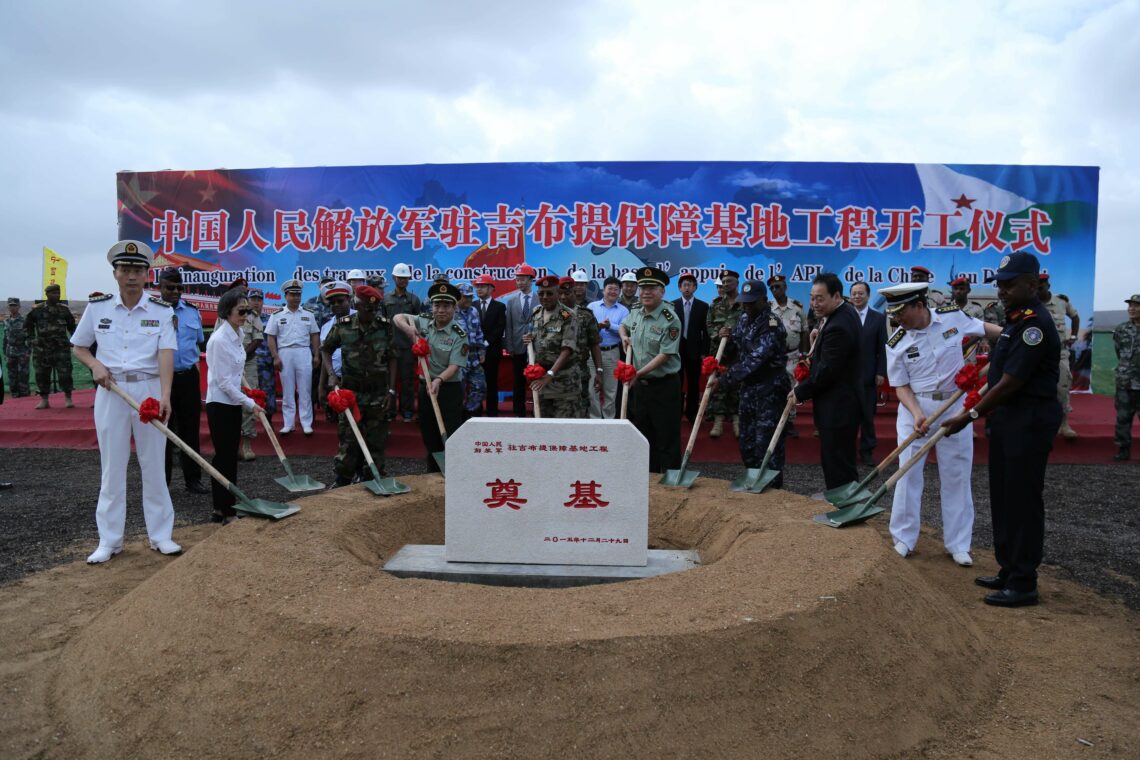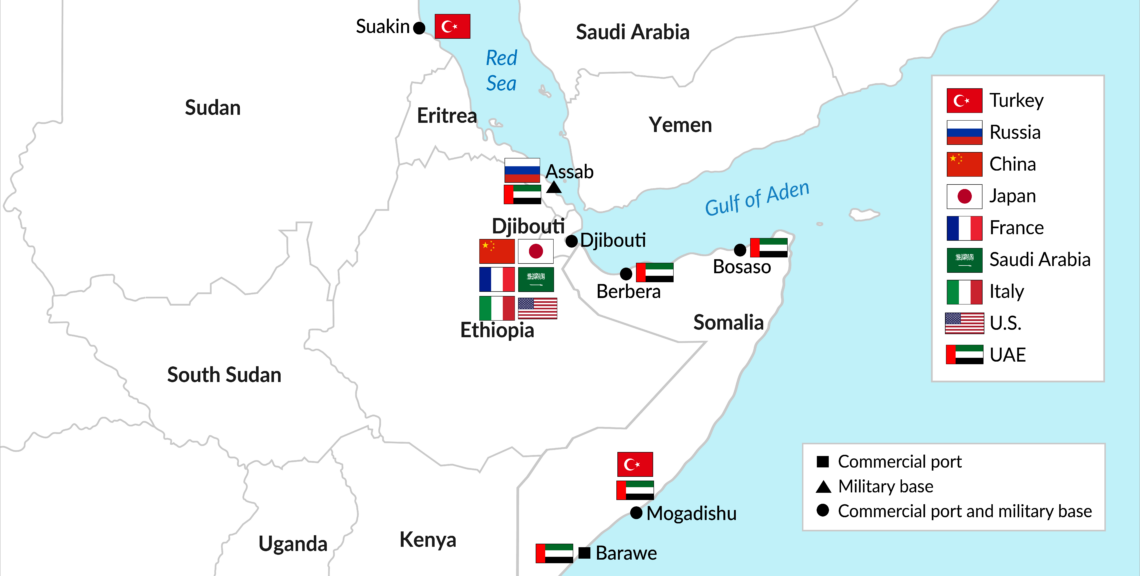The Red Sea becomes a dangerous flash point
Djibouti, Egypt, Eritrea, Jordan, Saudi Arabia, Somalia, Sudan and Yemen have come together to create a council to prevent the escalation of conflicts in the Red Sea basin. However, the intricate net of regional conflicts could prevent the organization from working effectively.

In a nutshell
- A council of Arab and African states was created in response to security concerns
- Disruption in sea transit through the area would severely affect world trade
- Internal rivalries could prevent a common front in the region
In January 2020, several steps were taken to deal with safety threats on the 2,250 kilometer-long and 350 kilometer-wide body of water linking Europe with Asia and Africa: the Red Sea. On January 6, 2020, the foreign ministers of eight Arab and African states neighboring the Red Sea and the Gulf of Aden met in Riyadh. Under Saudi leadership, they signed a charter establishing the “Council of Arab and African coastal states of the Red Sea and the Gulf of Aden.”
Nine days later, on January 15, Egyptian President Abdel-Fattah El-Sisi inaugurated the Bernice military base on the coast of the Red Sea – dubbed the “greatest military base in the Middle East” by local media. Situated 250 kilometers north of the border with Sudan, it extends over 60,000 hectares and includes air force and naval installations. It is intended to protect Egypt’s land and sea borders along the Red Sea basin.
Security concerns
Both events underline the determination of the two great Arab Sunni powers, Saudi Arabia and Egypt, to take the lead in regional security matters. To ensure the safety of the Red Sea, they will have to thwart separate attempts by Shia Iran and Sunni Turkey, which is close to the Muslim Brotherhood, to instrumentalize this sensitive area in their long-term bid to dominate the Middle East. Riyadh and Cairo have been encouraged by the European Union, which is increasingly worried by threats to the stability of a zone vital for international trade.
The Council of the European Union issued a warning on June 25, 2018, stating that: “[T]he stability of the Horn of Africa and freedom of navigation from the Indian Ocean through the Red Sea to the Mediterranean, both crucial to Europe, are being put in jeopardy by developments in the Red Sea region. The search for influence and strategic assets, together with the growing militarization of the Red Sea coast, are increasing risks within the region, with potential global consequences.”
Yet internal rivalries have prevented the formation of a united front.
Internal rivalries have prevented the formation of a united front.
The avowed purpose of the Council of Arab and African States of the Red Sea and the Gulf of Aden is to deal with piracy and smuggling as well as to cooperate on economic issues, especially fishing. As he signed the charter, Prince Faisal bin Farhan Al Saud, the Saudi minister for foreign affairs, made clear that security concerns were paramount in establishing the council. “We are very keen for the situation in the region not to escalate any further. It is certainly a very dangerous moment and we have to be conscious of the risks and dangers not only to the region but to wider global security.”
The minister added that there was no plan to form a common army since all member states have their own and could combine forces if needed. But can these eight states – Djibouti, Egypt, Eritrea, Jordan, Saudi Arabia, Somalia, Sudan and Yemen – set realistic goals and be an effective deterrent? Most of them have no wish to get caught in the feud between Iran and Saudi Arabia. Even Egypt, despite its very close strategic ties with Saudi Arabia, steers clear of confrontation with Tehran. Cairo has its hands full. The country is faced with an Islamic terror insurgency in northern Sinai and must maintain safety in the Suez Canal while wresting its share of Nile waters from Ethiopia.
Egypt is also closely monitoring steps by Qatar and Turkey to entrench themselves along the Red Sea. The El-Sisi government is actively backing insurgent Libyan General Khalifa Haftar, who is assisting Cairo in protecting their long common border. The civil war in Libya, where Turkey no longer tries to hide its support for Islamic organizations, is yet another threat.
Other members are involved in regional conflicts. Ethiopia, which has no access to the sea, shares borders with all countries along the Bab el-Mandeb strait. It has acquired shares in companies managing ports in Djibouti, Berbera and Port Sudan to ensure access to the sea. Yet it has not been invited to join the council, possibly because of an Egyptian veto over the bitter dispute surrounding the Renaissance Dam.
Somaliland, which is not recognized by the international community, was left out because of opposition from Somalia. Yet it has an 850-kilometer coast stretching from the Gulf of Aden to the Bab el-Mandeb strait. The Somaliland Ministry of Foreign Affairs and International Cooperation published a protest letter stating that the breakaway territory was aspiring to regional peace and thus demanded to be accepted as a stakeholder in the council, warning that it would not recognize it otherwise. Its application to the Intergovernmental Authority on Development (IGAD), a regional framework to promote security and economic development comprising Djibouti, Ethiopia, Eritrea, Kenya, Somalia, South Sudan, Sudan and Uganda, was also turned down.
Because of its strategic position, however, many countries in the region choose to cooperate with Somaliland. Oman and Ethiopia have established terminals in the port of Berbera, the economic capital. The port is managed by DP World, the large global terminal operator owned by the United Arab Emirates, which is in the process of building a huge new port intended to be part of China’s Belt and Road Initiative (BRI). Russia is reportedly weighing establishing a port in Berbera.
Can these eight states set realistic goals and be an effective deterrent?
To complicate matters further, the Supreme Houthi Political Council, which moved to the Yemeni capital Sana’a after its capture by the Houthi forces that now control most of the country, has announced that Yemen was no longer a member of the new Red Sea council. The declaration has no international validity but emphasizes the influence of Iran in the region through its proxies and its intent to prevent the establishment of a hostile coalition.
As to the new Egyptian military base, according to speeches delivered during the inauguration, its purpose is “protecting and securing the southern Egyptian coasts, protecting economic investments and natural resources in the area, confronting security challenges within the Red Sea, and securing global navigation traffic through the Red Sea to the country’s Suez Canal.”
The ceremony also featured the finale of the extensive Kader 2020 military exercises, as a show of strength. It was attended by Emirates Crown Prince Sheikh Mohammed bin Zayed Al Nahyan, deputy supreme commander of the Emirati armed forces and often considered the true ruler of his country.
Though the United Arab Emirates has economic and military interests in the Red Sea, it is not a member of the council, again because of internal rivalries. Nevertheless, it is a close ally of Egypt and cooperates with Cairo in backing General Haftar.
Abu Dhabi also has close ties to Saudi Arabia, but the two have clashed over the Saudi-led operation in Yemen. The Emirates back the separatist movement in southern Yemen. There are also tensions with Djibouti, which has nationalized DP World holdings in Doraleh, an extension of its main port and, last but not least, has diplomatic relations with Iran.
Vital connections
Since the inauguration of the Suez Canal in 1869, the Red Sea, the Gulf of Aden and the Bab el-Mandeb strait are the main seaways between Europe, East Africa and Asia, and a transit point for a considerable part of world trade. Should the area be blocked, merchant vessels and huge oil tankers would have to go around the Horn of Africa and the Cape of Good Hope, adding more than 4,000 kilometers to the journey, leading to an increase in oil prices. Iran’s push for hegemony, its threats to Saudi Arabia and its increasingly tense relations with Washington have ramped up anxiety in the world. The civil war in Yemen, now in its fifth year, and the occupation of the Hodeida port in 2015 by the Houthis, have brought the fight closer to the Bab el-Mandeb strait.
Little wonder that the area has become a geopolitical target with great powers scrambling to establish a presence. They focus mainly on Djibouti, which overlooks the west of the strait, on Eritrea and Somaliland north and south respectively, and on Yemen to the eastern side.
After Djibouti gained its independence in 1977, France retained a few military outposts. Immediately after the September 2001 attacks in the U.S., Djibouti leased former French Camp Lemonnier to the United States. It is now home to the Combined Joint Task Force – Horn of Africa (CJTF-HOA) of the U.S. Africa Command (AFRICOM). The intelligence hub monitors the activities of al-Qaeda and Islamic State. It also operates drones from nearby sites and other assets to target terror centers in Yemen and in Somalia where cells of al-Shabaab are still active.
In 2017, China established its first overseas military base in Djibouti, mustering some 10,000 troops. The sprawling economic complex – which holds a port, freight terminals and transit infrastructure – is part of the BRI. Italy and Japan have smaller bases in Djibouti, while India is negotiating with Japan to use its bases for military purposes. Russia is also holding talks with Sudan and Eritrea to set up military bases and anchorages for its vessels in addition to those in Berbera.
Facts & figures

The UAE has a military base in the Eritrean port of Assab, near the border with Djibouti. From there it launches strikes against the Houthis in Yemen. Turkey has a military base in the Somali capital, Mogadishu, and is leasing Suakin Island off the coast of Sudan for an indefinite time period, apparently to build military installations. Ankara has also leased an additional 780,000 hectares of Sudanese land to grow agricultural produce for the Turkish market.
Qatar, which had been close to ousted Sudanese ruler Omar al-Bashir, invested billions of dollars in economic programs. Following the coup, it increased its investments and sent humanitarian delegations to secure its position.
Sudan is still unstable. After protracted negotiations between the army and the Forces of Freedom and Change alliance, a transitional regime was formed, led by Sovereignty Council head Lieutenant General Abdel Fattah al-Burhan and a government chaired by a civilian, Prime Minister Abdalla Hamdok. Yet the new rulers had to quell a military uprising a few weeks ago and the country, which is still under American sanctions, needs investments and technology. On February 3, Israeli Prime Minister Benjamin Netanyahu and Lieutenant General al-Burhan met to discuss the country’s situation. A few days later, the Sudanese leader was invited to Washington by U.S. Secretary of State Mike Pompeo to discuss the cancellation of all sanctions.
Scenarios
There are some encouraging signs. Ethiopian Prime Minister Abiy Ahmed has ended a decades-old conflict with Eritrea, which earned him the 2019 Nobel Peace Prize. He could soon reach a compromise with Somalia on their common borders. On the other hand, the crisis with Egypt over the Renaissance Dam is not yet over, despite sustained negotiation in the last three months under American pressure. Efforts to end the Yemen civil war are stalling.
Talks between Saudi Arabia and the Houthis in Muscat did not yield results. Neither did the Hodeida cease-fire achieved in Stockholm. According to a recent United Nations report, in the last months of 2019 the Houthis received large quantities of modern weapons, including state-of-the-art drones and cruise missiles. The report stops short of stating that they were supplied by Iran, though there is no doubt about it. This indicates that Tehran intends to intensify the conflict.
Such wide-scale foreign interventions do not, unfortunately, guarantee the safety of the region. Further destabilization may be in the cards.
In such a volatile area, the best hope for the coming year would be a swift resolution of the conflict between Egypt and Ethiopia. A meeting in Washington on February 27 and 28, where the three countries were meant to sign a compromise drafted by the U.S., fizzled out. Pretexting the need for internal consultation, the Ethiopian delegation stayed home. If Ethiopia starts filling the Renaissance Dam before reaching an agreement, it could trigger an Egyptian military intervention.
What is the likelihood of a war between Iran and the U.S., which would spell disaster for the region and inevitably halt transit through the Red Sea? This being an election year, incumbent President Donald Trump will try to avoid an armed conflict. As to the Iranian leaders, should the economic situation become dire and threaten the regime, they might decide on a suicidal move. Last but not least, the Middle East being what it is, an isolated incident might ignite the powder keg. Of course, the coronavirus pandemic might make all such speculations moot.








